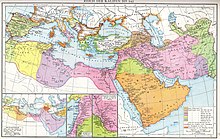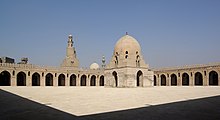Early Islamic time in Egypt
In connection with Egypt , the period between the conquest of the country by the Arabs in 642 and the beginning of the Fatimid rule on the Nile in 969 is called the early Islamic period .

The conquest of Egypt
After the conquest of Syria by the Muslim Arabs, they began to penetrate further into Egypt at the end of 639. The caliph Umar sent his general Amr ibn al-As , who had already conquered Palestine and now advanced with 9,000 men to one of the most important provinces of the Byzantine Empire (the Egyptian grain deliveries were vital for Constantinople ). The decisive event is the siege of the fortress Babylon near the ancient Heliopolis , which controlled the river crossing above the delta. After their capitulation in 641, almost the whole country was occupied, the new, rapidly blossoming center of which was al-Fustat , Amr's camp near Babylon; Here the conqueror had the first mosque in Africa named after him built. The old capital Alexandria , the seat of the patriarch Cyrus (called Muqauqis by the Arabs), only surrendered after Herakleios' death in 642, when the Copts - who made up the majority of the population throughout the early Islamic period - were guaranteed freedom of religion . Byzantine attempts to reclaim Alexandria from the sea were to be unsuccessful.
Early Islamic period
After the conquest, Egypt, whose first Muslim governor was Amr until 644, was initially the starting point for further Arab campaigns in North Africa . While advances to Nubia (641, 651) failed and the independence of the local Christian empire Makuria had to be recognized by treaty in 652 (the border remained with Aswan ), despite a few setbacks, the Maghreb was conquered , which was also under the governor of Egypt until 705. In the period that followed, Egypt was ruled first by the Umayyads , then (from 750) by the Abbasids and was an important base for the struggle for sea control in the Mediterranean with Byzantium. Refugees from al-Andalus conquered the Byzantine Crete from Egypt , where they founded their own emirate .
From the 9th century onwards, the Abbasid caliphs' control over Egypt began to loosen after they had appointed Turkish soldiers ( Mamluks ) as governors. In 868 , Ahmad ibn Tulun actually made himself independent from the caliphate and gave Egypt back the political independence it had lost after Cleopatra's rule. He reorganized the country according to his ideas and with his newly created army even conquered the Levant as far as the Taurus Mountains . Al-Fustat was expanded to include a new district called al-Qatai, of which the outstanding Ibn Tulun mosque is still preserved today. Founded by Ahmad dynasty Tulunids whose representatives schillerndster sure Chumarawaih is, could indeed hold only until 905 when the Abbasids regained control over the country, but won Egypt already 935 again its independence. It was again a relatively short-lived foreign regime, which was again established by a Turkish commander: Muhammad ibn Tughj . Like Ahmad ibn Tulun, the Ichschid (an old Central Asian title) exploited the weakness of the caliphate to found a dynasty of its own, that of the Ichschidids . A fleet was built under her, but northern Syria had to be ceded to the Hamdanids . By promoting the arts as regent and z. For example , when the poet al-Mutanabbi was drawn to his court, the Abyssinian eunuch Kafur gave the Ichschidid rule even more splendor before the dynasty was attacked by the Ismaili Fatimids from Ifrīqiya and finally overthrown. In 969 Dschauhar as-Siqillī conquered Egypt, whereupon the Fatimid caliphs elevated the country to the new center of their empire - completely independent of the Sunni Abbasids - and founded the royal seat of Cairo north of al-Fustat .
The increasing independence of Egypt was also favored by an economic boom. The unrest in Abbasid Iraq led to the fact that the lucrative sea trade between India and the Mediterranean region gradually shifted from the Persian Gulf back to the Red Sea since the 10th century , which thus regained its old primacy. From this, the rulers of Egypt were able to achieve considerable income, which enabled them to pursue an independent policy towards the Baghdad caliphate. Apart from that, the country remained completely shaped by its agriculture, which was dependent on the Nile and traditionally required a high degree of central planning and regulation.
literature
- Ulrich Haarmann: History of the Arab World , Munich 2001.

